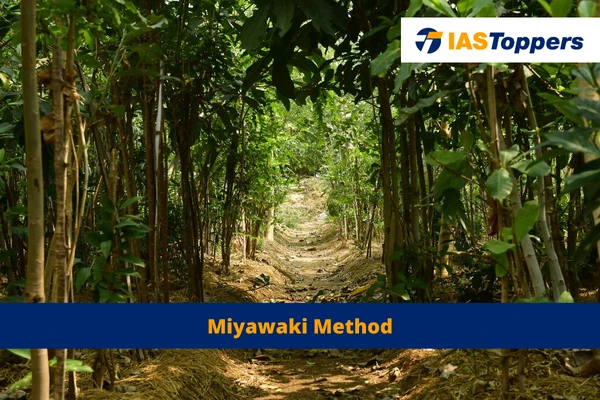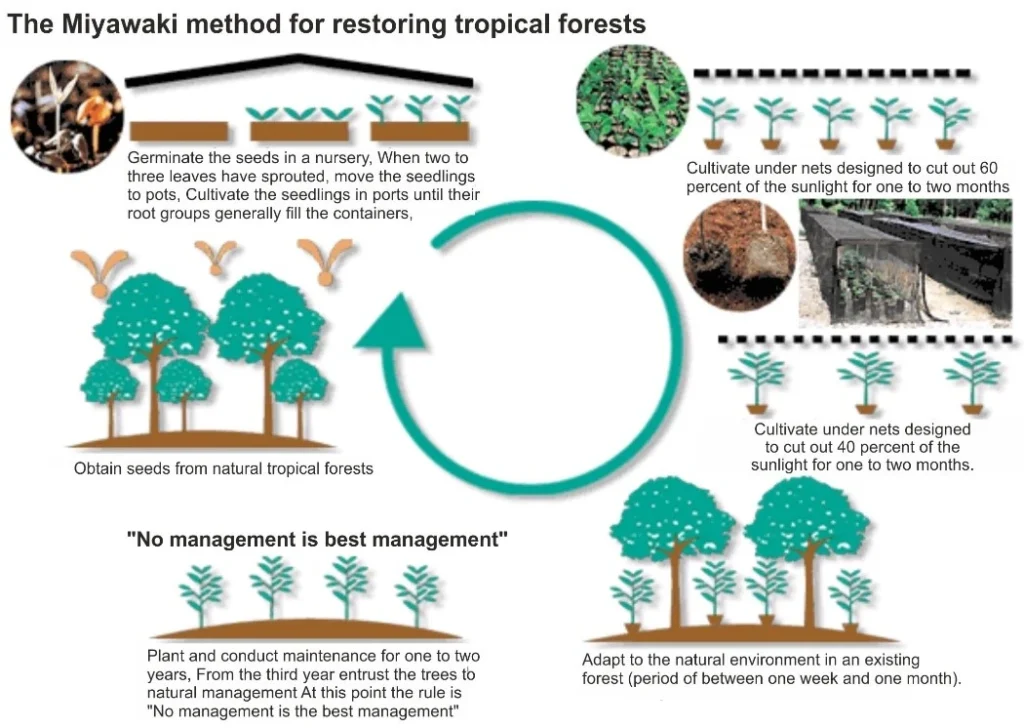Miyawaki Method is an approach of establishing forest cover by plantation of many seeds of native tree species in a small piece of land. In this article, you will learn about Miyawaki Method, definition, history, principles, benefits of Miyawaki forest, disadvantages.
This article will provide key insights for GS Paper-III Environment and Ecology section of UPSC IAS Exam.
Table of Content
- Table of Content
- What is Miyawaki Method?
- Principles of Miyawaki Method
- History of the Miyawaki Method
- How to create Miyawaki forest?
- Advantages of Miyawaki Method
- Applications of the Miyawaki Method
- Disadvantages of Miyawaki method
- Conclusion
- Frequently Asked Questions
- Reference
What is Miyawaki Method?
- The Miyawaki Method is an approach of establishing forest cover by plantation of many seeds of native tree species in a small piece of land.
- The Miyawaki Method utilises degraded land previously that was utilized for agriculture or construction.
- The trees planted using the Miyawaki Method exhibit accelerated growth which may accelerate the process of forest creation and enhance carbon capture.
- When implemented in smaller afforestation projects, especially in urban areas, it offers more advantages than conventional forestry methods.
- The Miyawaki forests display a greater biodiversity as compared to nearby woodlands, making it ideal to establish diverse forest ecosystems.
Principles of Miyawaki Method
- The Miyawaki forest Method adheres to natural reforestation principles as it plants native trees and replicates the processes of natural forest regeneration.
- The saplings become self-sustainable after the first three years.
- By doing so, a resilient and flourishing forest ecosystem is created, characterized by species that complement one another.
- The selection of tree species initially for a specific area is based on the concept of potential natural vegetation (PNV), representing the vegetation that may naturally exist without human intervention.
- Despite challenges in defining native species, those adapted to local conditions have better chances of survival and contribute more to biodiversity than recently introduced species.
- Unique feature of Miyawaki forests is the high density at which seedlings are planted.
- This is similar to the process of the natural regeneration in forests when a gap in the canopy opens up due to a fallen larger tree.
- The saplings grow rapidly in order to compete for light, and natural selection favours the fastest-growing tree that results in the thinning of trees.
- The competition results in densely populated forest that emerges within 20 to 30 years instead of 150 to 200 years.
History of the Miyawaki Method
- The term “Miyawaki Method” is named after its creator Akira Miyawaki.
- Dr. Akira Miyawaki has mentioned about the technique in his research in plant ecology and phytosociology.
- Miyawaki has applied these principles to the Japanese landscape and became fascinated by the remnants of ancient forests known as Chinju-no-mori, found near temples and shrines.
- The Chinju-no-mori was sacred groves consisting of native trees like Japanese blue oak, Japanese chestnut, and Sakaki, in contrast to the dominant coniferous trees that were introduced from other regions.
- The forests also displayed a layered structure with various canopy, tree, sub-tree, shrub, and ground-covering herb species.
- Using these observations, Miyawaki devised a new approach to forest planting based on native vegetation suited for specific areas.
How to create Miyawaki forest?
- The native trees of the region are identified and divided into four categories as per their heights shrub, sub-tree, tree, and canopy.
- The quality of soil is analysed and biomass is identified that will help to enhance its perforation capacity, water retention capacity, and adds nutrients to it.
- A mound of soil is built and the seeds are planted at a very high density with minimum three to five sapling per square meter.
- The ground is covered with a thick layer of mulch.
Advantages of Miyawaki Method
- In a Miyawaki forest, the trees experience rapid growth and reaches a stable multi-layered forest community within 20 to 30 years.
- This is faster as compared to traditional methods that take hundreds of years.
- The accelerated growth in Miyawaki forests results in higher carbon absorption as the trees grow approx. at a rate of one meter per year, absorbing more carbon as compared to plantations or standard afforestation projects.
- The density of trees in a Miyawaki technology is thirty times greater, leading to greater carbon sequestration.
- The Miyawaki plantation method was also successful in challenging environments such as arid Mediterranean habitats, where other planting projects have failed.
- This success is caused by the high survival rates of native trees that thrive in their adapted conditions and have greater resilience to environmental changes.
- The Miyawaki forests exhibit more biodiversity than that of neighbouring woodlands by an average of 18 times.
Applications of the Miyawaki Method
- The Miyawaki technique of plantation can be used for creating micro forests in urban areas, restoring rainforests and addressing the challenges of arid Mediterranean habitats.
- They can offer protection against tsunamis, stabilizing mine dump slopes, acting as a shield against cyclones, and contributing to carbon sequestration.
- Urban environments are implementing Miyawaki forests to increase the tree planting in cities.
- This method maximizes the utilization of available space which is already rare in urban environments.
- Urban forest helps in lowering local temperatures (with decrease of up to 1.3°C), enhance air quality by reducing pollutants, sequester carbon, improve the well-being of residents, and create natural havens for invertebrates and birds.
Disadvantages of Miyawaki method
- Recognizing the suitability of vegetation for a specific area can aid afforestation projects in establishing forests that support native wildlife.
- The Miyawaki method may result in creation of monotonous forests due to the trees being of the same age.
- This method requires a higher number of seedlings, making it more expensive.
- The idea of planting fixed compositions of vegetation is not possible as ecosystems are not static.
- Such forests may lack plants with medicinal properties that is common in natural forests and grow without any external aid or seedlings.
- Such forests may not able to bring rain that is common in natural forests.
Conclusion
Miyawaki forest method in India has been launched by many State and local government such as Chennai and Mumbai based initiatives. Kerala Tourism has launched a project to create Miyawaki model micro forests at 22 tourism spots in 12 districts across the state. Miyawaki afforestation method will serves as a future urban forestry method in India.
Ref: Source-1
| Other Articles in Environment & Disaster Management | |
| No-till farming | Cropping systems |
| Green GDP | Vertical Farming |
| Compensatory Afforestation | National Green Tribunal |
FAQs (frequently asked question)
What is Miyawaki Forest?
The Miyawaki Method is an approach of establishing forest cover by plantation of many seeds of native tree species in a small piece of land.
What are some of principles of Miyawaki Method?
The Miyawaki forest Method adheres to natural reforestation principles as it plants native trees and replicates the processes of natural forest regeneration.
Who has created Miyawaki Method?
Dr. Akira Miyawaki has created Miyawaki Method.





